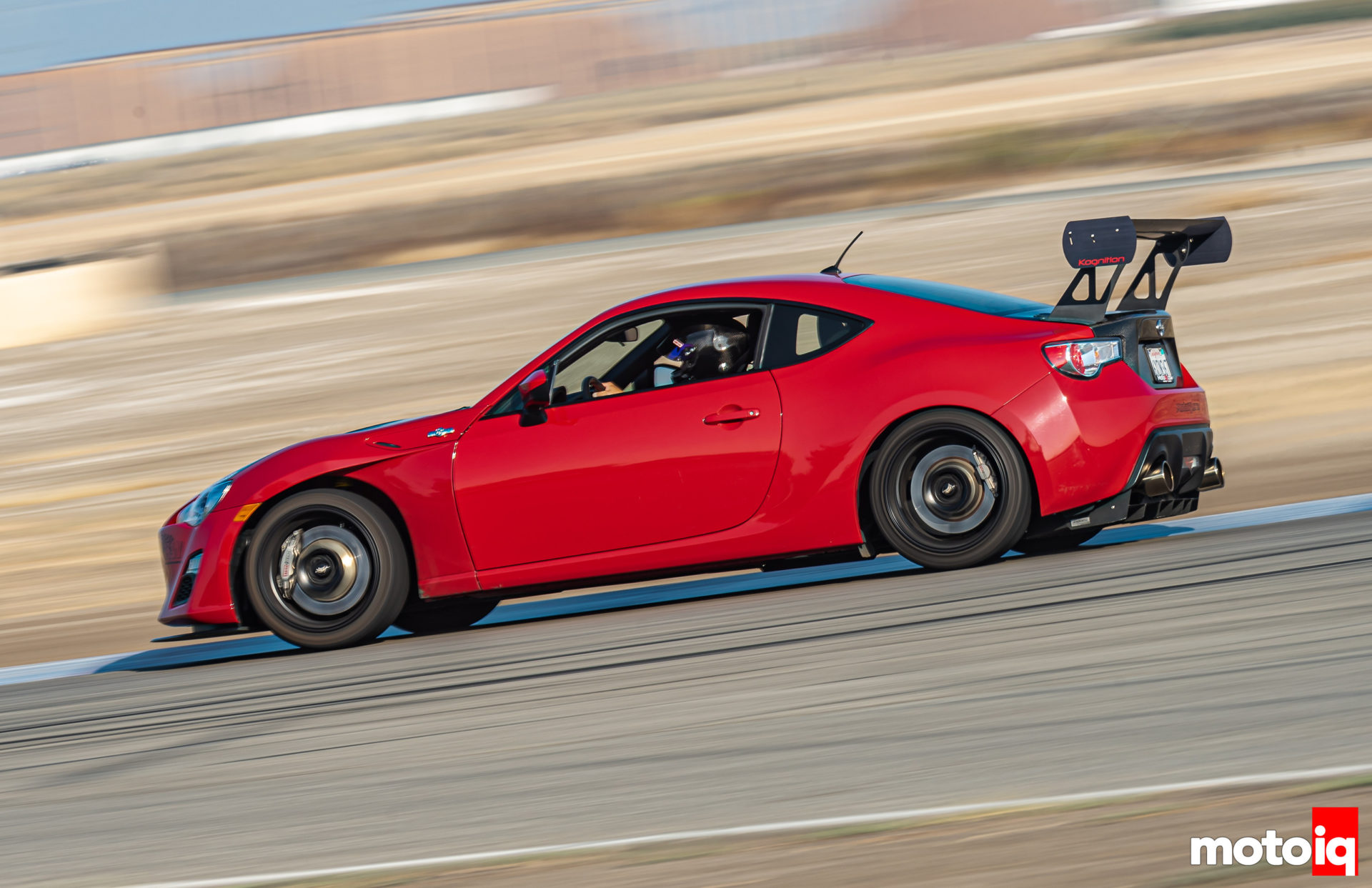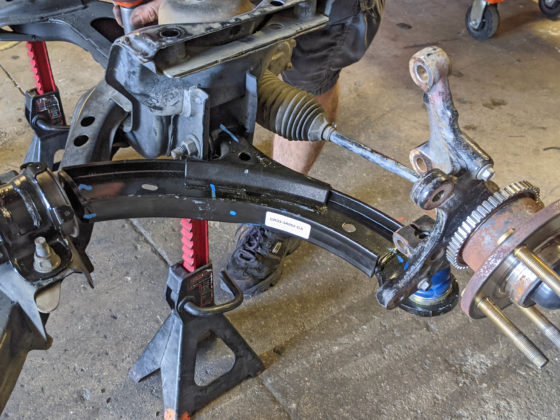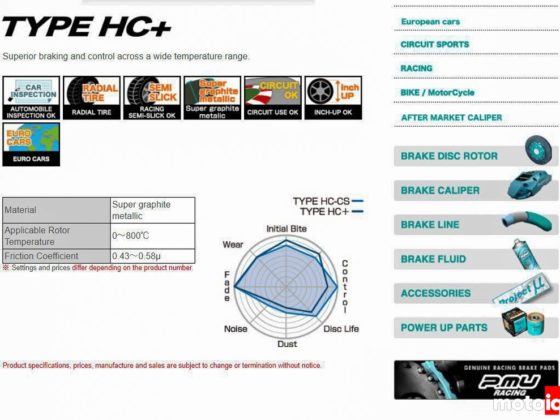
We had dusted off Project FR-S for an industry track day at Buttonwillow Raceway last month. While we had run the car in the winter on small courses like Streets of Willow and shorter courses like a roval at Irwindale Raceway, this was the first time we had taken it out on a bigger longer course. When doing a long session, we noticed that the power really faded toward the end of the session. The ECU was pulling timing or not giving us full drive-by-wire throttle in a soft limp mode even though our water temperature was smack in the middle of the normal range on our gauge thanks to our Koyo radiator. Now the factory gauge isn’t the best for monitoring the engine but from doing research on what others were experiencing with forced induction track-driven FR-S’s, our oil temperature was probably moving past 260 degrees and the engine was protecting itself. At 260, bad things start to happen. The engine’s bearings are made of soft low melting point metals and they start to lose load-bearing capacity right at around 260 degrees F. If you run high-quality synthetic, your oil is still good, as long as you are not running something like 0w-20 super mileage oil but your bearings are getting softer and not happy. It is our opinion that high oil temps are one of the causes of the FA20 engine’s propensity to have oiling problems when the power is turned up on the track. For the sake of our engine, we needed an oil cooler and Greddy Performance Products came to our rescue with one of their beautiful units!

The Greddy oil cooler uses a 10-row tube and fin, heat exchanger. It is not the biggest cooler on the market but it is the biggest that will fit in the area it is designed to go in. Greddy’s mounting position on the passenger side of the front of the car is a big advantage for forced induction cars that have an intercooler. This position means that the oil cooler isn’t fighting for space in the front of the car and is not heating up air that the intercooler, AC condenser, and radiator are dividing up. We really prefer oil to air oil coolers as we find that they work much better. For coolers that share coolant with the radiator, the working cooling medium is the coolant which is usually well over 200 degrees under track conditions vs the oil to air coolers’ ambient air temperature. With an oil-to-water cooler, the oil is also dumping a lot of heat directly into the coolant which the radiator must get rid of.

The Greddy kit comes with a thermostatic oil filter adaptor, mounting brackets, and high-quality hose and fittings. Greddy also has a cooler kit that comes with an air duct which is the preferable part for track use but they were out of stock so we would have to fabricate our own.

The billet adaptor takes the place of the stock oil filter and allows the fitting of the oil coolers’ thermostat.




19 comments
Great to read another update for this project.
Do you still have some WiseFab suspension parts to fit to the car?
The car has Wisefab suspension, look for an article on that coming soon!
I’m really looking forward to reading that! Thank you for the time and effort you put into these projects, and sharing the process and results of it all. The knowledge and experience you have shared since the SCC magazine days has always been informative and engaging.
I really like the cooler, but I swear that somebody told me that anodized surfaces didn’t dissipate heat as well. Not sure if I I am remembering that correctly. Also, I would think that black would be the best color for a cooler.
Anodized parts don’t dissipate heat as well. This isn’t anodized, it’s paint. Anodizing works on reactive nonferrous metals. Paint doesn’t dissipate heat as well either and neither does bare aluminum or copper with their natural oxide layer as well. You just can’t win! Black does radiate heat better and there are coatings that enhance this.
Mike, in your opinion whats the highest acceptable oil temp on track for a street/track car (aka not full race car)?
Bearings start to lose load-bearing capacity at 260f oil temp, they melt at around 600 degrees so they start to lose strength by the time the measurable oil temp is around 260. The oil is carrying heat away from the bearings.
From doing lab R&D for a company that solely did bearings, I’d go a bit more conservative than that; 260F is sort of where I’ve seen stuff drop off a cliff. Bearing overlay is already at about half its room temperature strength at 210F. That’s ignoring what you’re doing to your oil viscosity, though this is talking in terms of temperature at the bearing.
Yup.
I’ve been running my 93 LT1 Camaro past 300 regularly since 2013. In that time I managed to push an oil seal out, run the car low, and spin a rod bearing. The rest of the rods and all the mains were immaculate. I know the science says it’s bad, but my primitive old knuckle dragging V8 doesn’t seem to mind as long as I keep it full. I don’t even run synthetic, just Valvoline VR1 SAE40. Being a dino oil the straight weight helps with stability. Of course this is a track only car.
There are 2 items in that kit that caught my eye. First was the cooler orientation. With both ports facing up, there’s the possibility of trapping air in there. On my Camaro I put it in rotated 90 degrees with oil in the bottom and out the top. I understand this is not possible with what you have and what you have definitely works. The other thing was the supplied 90 degree fittings. I went with larger mandrel bent 90 degree fittings on mine out of concern for flow and turbulence.
Noticed you hit 300 degrees and you spun a bearing? Wonder why? Your oil temp is a big factor in addition to running low. Bearings start to lose strength after 260F oil temp. If anything happens or not depends on how much reserve you have. Stock engine? Maybe more, On the track or modded? A lot less.
Yes, but I don’t believe the oil temp to have had anything to do with it. The car ended up being a good 2 quarts low and the pickup was JB Welded to the pump and rotated about an inch too high so ignorance on behalf of the PO and me not lifting when I noticed the pressure bouncing mid corner was the cause of death there. 260 is commonly touted as the limit on here but I’m in the minority having an oil cooler at all in my class. I have no doubt that the other cars in my class are hitting 300+ (stock motors) and not blowing up. I’m not advocating to run oil at 300+, but I haven’t seen it be a death sentence myself. I rebuilt the current motor in 2015 and can’t count how many times I’ve raced at 300+. With everyone else doing it, there’s no way it’s luck. I wonder if certain motors are more sensitive than others?
Bigger diameter, and chiefly width, means the bearing is less loaded; 260F isn’t “the metal in the bearings has turned to liquid” but “it’s turned delicate as hell” so being comparatively more gentile helps some. Subaru bearings are terrible by this measure and need all the help they can get.
No one ever believes me when I say this.
I should see if I can put together enough not-proprietary data to do a good blog post or something on how bearings work – reciprocating engine bearings are a lot of special cases piled on top of each other. There’s some people who have gone and authoritatively posted a lot of true-but-not-the-full-story data because their engine combination, like many American V8s designed in the 60s, has very generous bearing sizes.
I would love for you to do an article on this. No one ever believes me.
I’ll see what I can put together over the next few weeks; probably will have to make my own diagrams of stuff too, to not violate copyright. But I mean, the best I’ve seen in searchable descriptions is a basic steady state fluid film bearing… which is lovely if we were driving gas turbines but piston engines see peak bearing loads that steady state guidelines say won’t work. Even that has some stuff going on that I’ve seen some engineers just not get; I was fortunate to be able to pick the brains of people with PhDs in the subject.
My point is that, even if stuff is weaker at that temperature, the effect of it isn’t realized in my small world. I believe you guys that stuff happens at 260, but if it isn’t enough to hurt the motor even long term then why get worked up over it? On a good day my oil only gets up to 270. If you do do the article, it would be great to caveat with things like bearing surface area and point out some motors that you know in particular are and are not susceptible to catastrophic failure north of 260. Also bear in mind our GM cars are saddled with restrictor plates, stock motors with stock rev limits when I make these claims.
This seems like a great upgrade and some cheap insurance. My only issue is I hate the idea of taking the front bumper cover off my FR-S, only because so many people have broken the side tabs on them. Did you have any issues refitting the bumper cover back on?